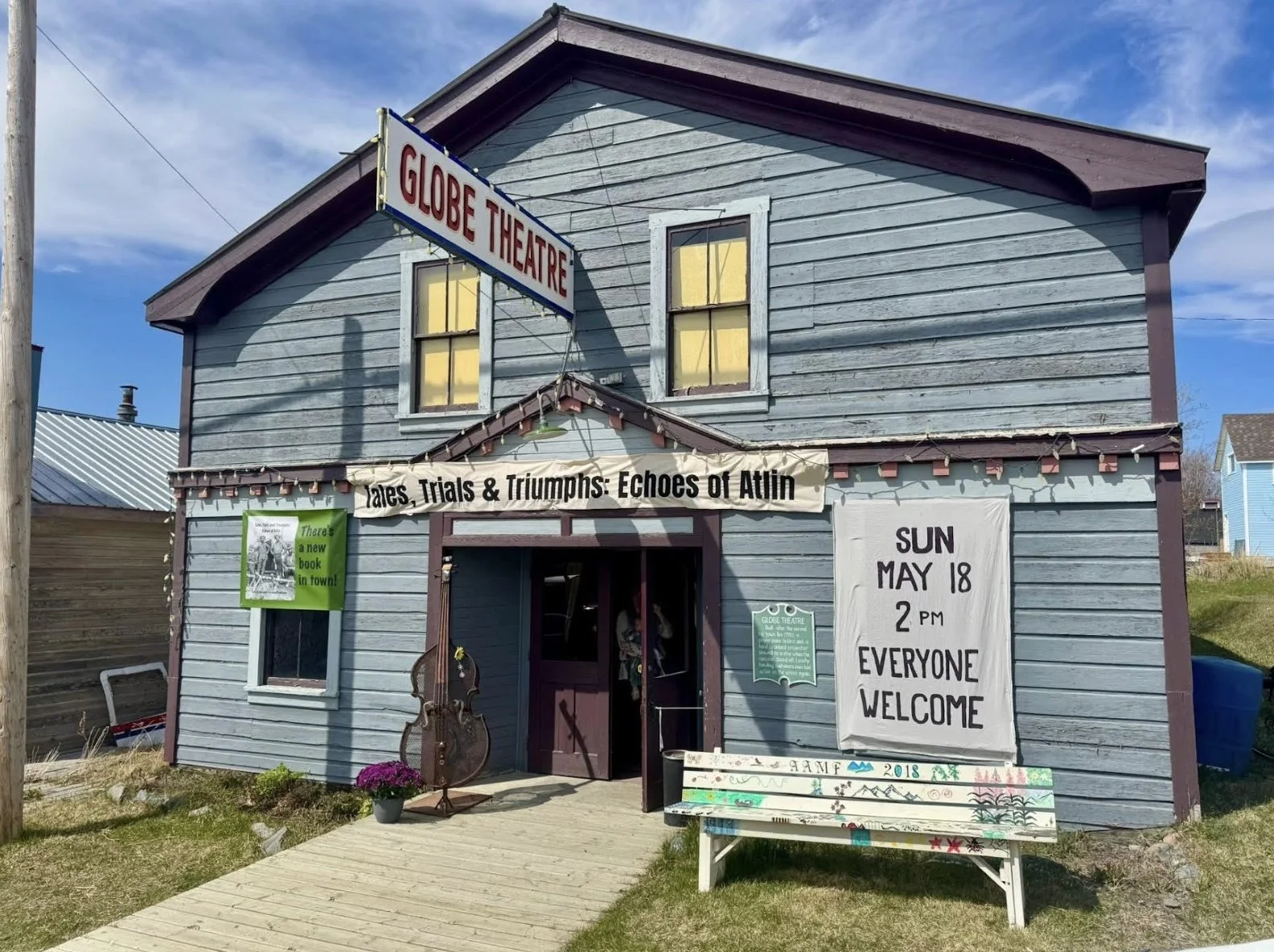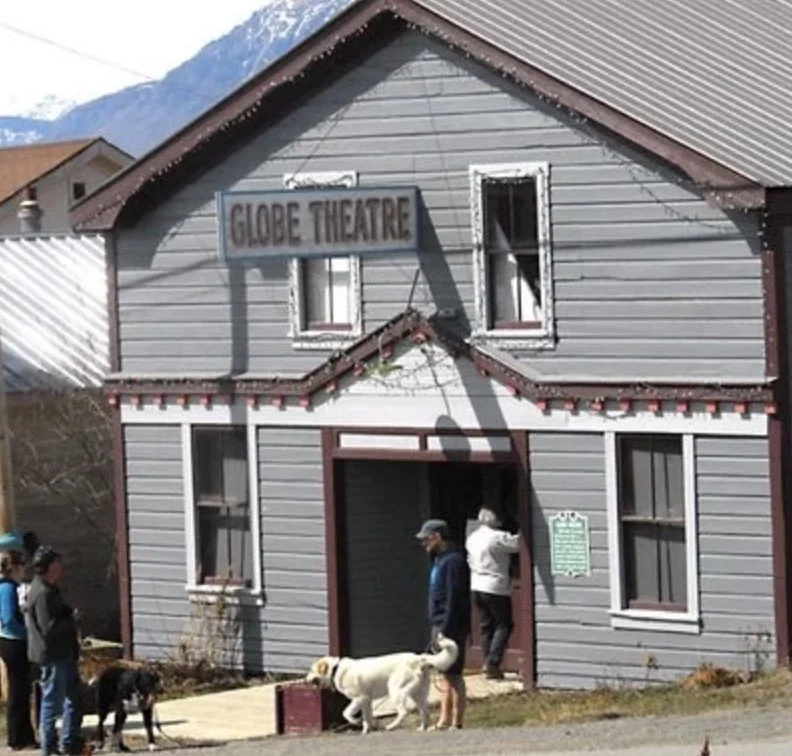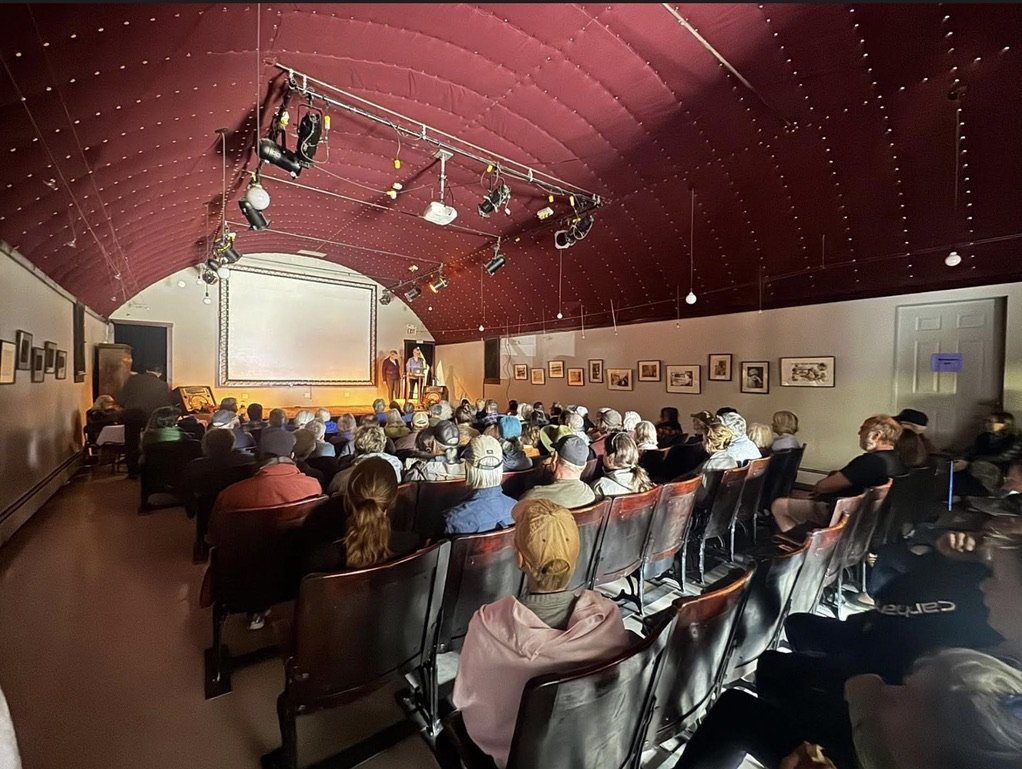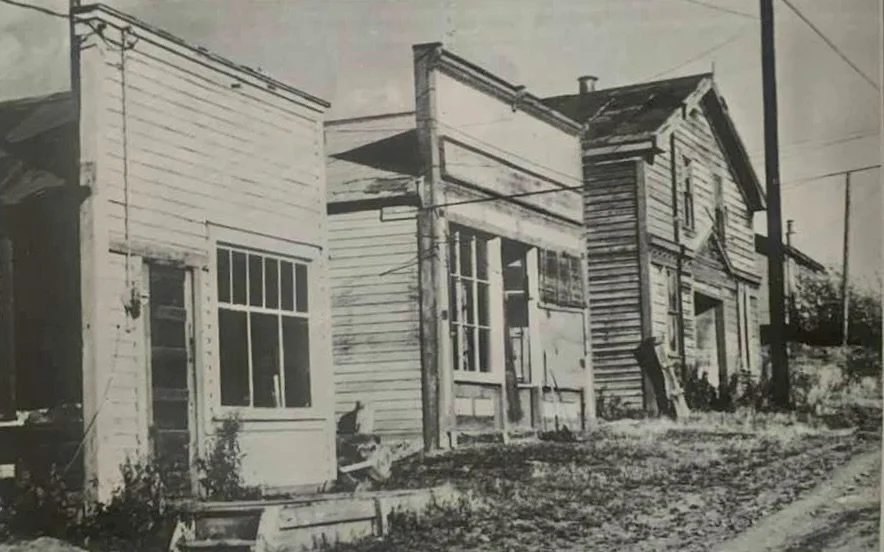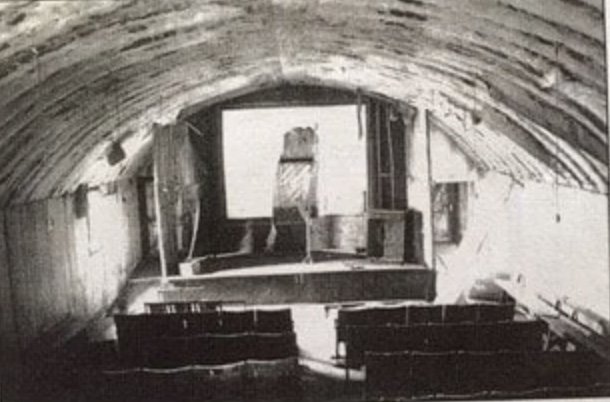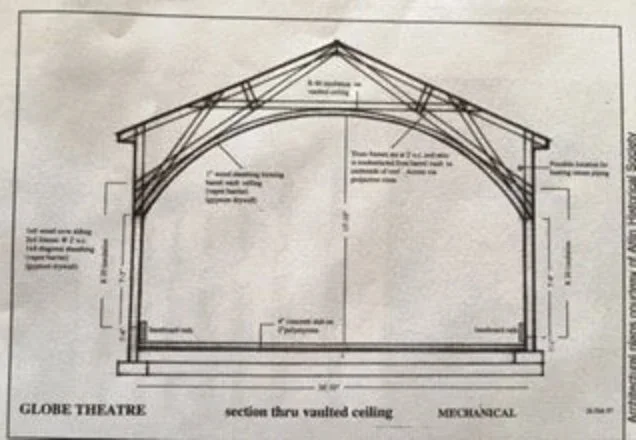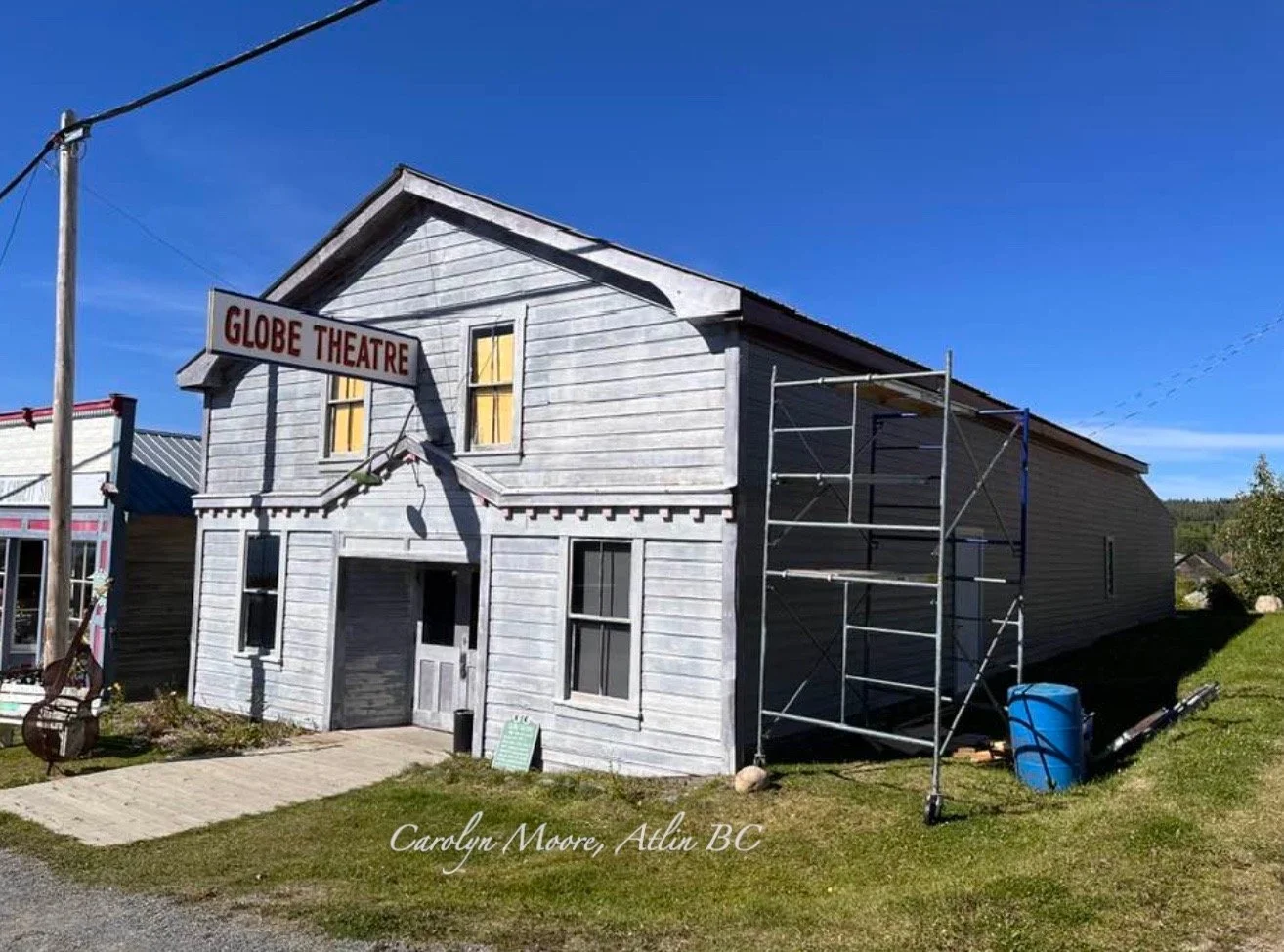The Globe Theatre
Rentals
The M.V. Tarahne and the Globe Theatre can be rented for weddings, meetings, concerts and other private functions. For more information, call 250-651-7522 or contact the AHS at atlinhistoricalsociety@gmail.com
Held in 2025 - Book Launch for Tales, Trials, & Triumphs: Echoes of Atlin https://www.atlinhistoricalsociety.ca/store
A bench from the Atlin Arts and Music Festival sits outside the theatre. Photo by Carolyn Moore
A Lasting Testament to the Past
The Globe Theatre in Atlin stands as a lasting testament to the town's heritage from the Gold Rush era. The theatre was constructed in 1917 by Edwin Pillman after a fire ravaged a significant portion of the town's core. Edwin Pillman, a genuine northern entrepreneur, was not only a prominent merchant but also an undertaker and movie operator. Amongst the town's older residents, he is warmly remembered for his multifaceted contributions to Atlin's community.
Rentals
The M.V. Tarahne and the Globe Theatre can be rented for weddings, meetings, concerts and other private functions. For more information, call 250-651-7522 or contact the AHS at atlinhistoricalsociety@gmail.com
The History of the Globe Theatre from 1917 til the present day.
Before its restoration in 1998, the Globe Theatre had fallen into abandonment. Weather infiltration was evident, the roof sagged, and decay had pervaded the sills.
Representative of the prevailing northern architectural style of its time, the Globe was rapidly erected, utilizing sills placed directly on the ground. The walls were adorned with rose-colored craft paper, possessing the weight of light blotting paper, secured in position by tin washers to ward off drafts. Despite its unassuming exterior, the building concealed a modest yet extraordinary vaulted ceiling. The economic downturn of the 1930s eventually reached Atlin. Tourism had previously flourished from the early 1900s to the 1920s. As tourism declined, Atlin dwindled. In the early 1940s, Pillman left the north and retired. This marked the closure of the Globe.
After the Globe Theatre closed in the 1940’s, Atlin remained tranquil, and the theatre fell into disrepair.
However, in the 1970s, the town experienced growth, and by the time of the 1995 Strategy Report, the theatre came under the ownership of the Atlin Historical Society (AHS).
The vaulted ceiling structure
The Theatre in 2025.
Restoration Efforts begin in 1995 - Methods and Resources
In 1995, the Globe Theatre faced significant deterioration, with rotted sills and joists, water seepage, sunken walls, and a predominantly decayed and distorted floor. The 9x12-foot movie screen was torn, and the original seating had also degraded. Undertaking a three-year rehabilitation effort with a budget of $180,000, the Atlin Historical Society (AHS) secured $150,000 in assistance over three years from British Columbia’s Ministry of Small Business, Tourism, and Culture. An additional $20,000 was obtained through the Vancouver Foundation, specifically earmarked for lighting and projection equipment. This funding aimed to transform the theatre from a mere heritage site into a cultural asset for the isolated community. The remaining capital, covering project administration, research, and the hundreds of volunteer hours necessary for the project, was led by the AHS with robust community support. The invaluable volunteer efforts played a crucial role, saving the Globe from requiring many more tens of thousands of dollars in restoration costs.
During the first year of restoration, the Globe Theatre's shell was meticulously preserved. The perimeter underwent re-supporting, being raised and leveled onto a new continuous concrete footing. The entire building was clamped and compressed into place while the roof line was jacked back into its proper position. Discrete steel rods were strategically employed to secure and support the arch in its rightful place. A fresh roof skin was applied, and necessary glazing was replaced.
Photo at left shows the patched roof of the theatre.
In the second year of the restoration process, the focus shifted to enhancing safety measures. The building was insulated and drywalled for fire safety, and a new insulated concrete floor was laid. Additionally, a rear addition measuring 28x16 feet was introduced to facilitate backstage activities for live entertainment. This new space also accommodated the installation of heating and plumbing equipment, which were absent in the original theatre.
In the third and final year of the restoration, meticulous attention was given to both interior and exterior details, bringing the project to completion. The exterior received a fresh coat of paint, and a sign replicating the original one, now housed in the museum, was installed. Inside, enhancements included padding the vaulted arch to optimize acoustics, hand upholstering it, and affixing tin washers to recreate the theatre's original aesthetic. For practicality and ease of maintenance, affordable linoleum was chosen for the flooring. Salvaged materials were repurposed to construct the new stage. A lace and grommet movie screen, mirroring the size and style of the original, was installed, and the original seating underwent repainting and reupholstering. To complete the seating arrangement, additional used chairs were purchased.
Before and after the restoration efforts. The original interior, while modest, retained enough elements to facilitate restoration. The auditorium was finished in a manner closely resembling its original form, right down to a movie screen that faithfully replicated the design of the original.
Reopening in 1998 - 100th year Anniversary of the Gold Rush
On August 1, 1998, Atlin united in celebration, marking both the centennial and the grand opening of the theatre through a street-side ceremony featuring ribbon-cutting, volunteer recognition, and reflections on history. Among the participants were Edwin Pillman’s great-grandson, B.C.’s Lieutenant Governor, numerous visitors, and long-time residents, all contributing to the festive atmosphere. The evening unfolded with a nostalgic local performance featuring singing, storytelling, and dance, inaugurating a new chapter in the Globe's history. As the emotionally charged day and night concluded, all performers returned to the stage for a rendition of "Will the Circle Be Unbroken," with verses specially crafted to chronicle the theatre’s resurgence in Atlin’s community.
The success of the project was a testament to the commitment and dedication of volunteers, who tirelessly worked for weeks, complemented by the creativity, ingenuity, and skills of the local project contractor. The final result surpassed even the highest expectations, and since its grand opening, the Globe has become a catalyst for a new live theatre group and has hosted a diverse array of events, including movies, slide shows, and concerts. The Historical Society takes immense pride in witnessing the theatre reclaim its role as a vital player in the life of Atlin.
These architectural drawings of the Globe offer intricate details regarding the building’s layout and proportions. First, a cross-section unveils the building's internal structure, showcasing the impressive vaulted ceiling. In the other photo, the floor plan delineates the theatre's layout post-renovations. The newly added backstage section not only facilitated live performances but also accommodated essential space for mechanical and electrical systems.
In 2025, the Globe needed another coat of paint. It was hand-scraped and re- painted. Restoration never stops.
Columbine grow wild outside the Globe Theatre Photo by Carolyn Moore
